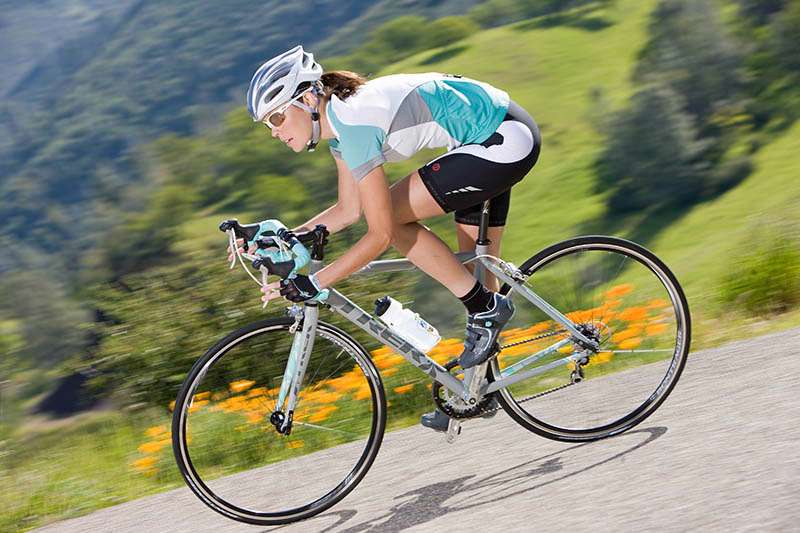You’ve heard of cyclocross bikes before. You might have even seen a few and not realized it.
How does a cyclocross bike differ from your standard road bike?
Maybe you’re in the market for a bike and you want to figure out which bike best fits your cycling needs. Figuring this all out can be a bit confusing, which is why we’re here to help you.
Key Takeaways
To put it simply, a cyclocross bike is a hybrid of a mountain and a road bike. It has a similar looking frame to a road bike but with more tire clearance in the frame and fork to accommodate beefier tires for off-road riding.
Road bikes are designed strictly for road performance. This means a more aggressive bike geometry, lighter and more aerodynamic frames with narrower tires and wheels.
On This Page
Frame Geometry
CX bikes may have many similarities with road bikes. They both have drop handlebars, and they both have the same sized 700c wheels. But look closer, and the differences become more noticeable.
CX bikes typically have a shorter reach and higher bottom bracket, resulting in a taller and more upright position. This also allows for more tire clearance like their mountain bike cousins for pedaling on off-road terrain or bunny hopping over barriers.
Top tube lengths on CX bikes are generally shorter for a shorter reach and more upright position in the cockpit.
CX bikes will also typically have longer seat stays which increase the bike’s wheelbase. A shorter wheelbase allows for tight cornering quick maneuvering, a requirement for road bikes that may need to make aggressive turns or respond quickly in a group of riders. A longer wheelbase is more stable, which is a necessity for offroad riding.
Example - S-Works 7 vs CruX Geometry

Let’s take a look at examples that illustrate this point. Specialized’s top-end road bike, the size 52 S-Works Tarmac SL7 vs its cyclocross equivalent, the S-Works Crux. A look at both bikes’ geometry charts above reveals key differences in their design.
Whereas the Tarmac features a shorter stack of 517 mm, allowing the rider to take an aerodynamic position, the Crux has a significantly taller stack at 554 mm, facilitating a more comfortable and stable ride.
The Crux has a longer chainstay at 425 mm whereas the Tarmac is just 410 mm. This results in a longer wheelbase for the Crux, 1,008 mm vs 975 mm for the Tarmac, which translates into more stability for the Crux and more agility for the Tarmac.
You’ll also notice that the bottom bracket height is higher on the Crux, at 281.5 mm than it is for the Tarmac, which has a BB height of 266 mm. The Crux’s higher bottom bracket helps to facilitate offroad riding, especially when going over obstacles.
Example - Trek Emonds vs Boone Geometry

Tire Size and Clearance
On a road bike, you’d typically be riding a narrower tire. A cyclocross tire, in comparison, is significantly wider.
CX bikes are typically fitted with 32c tires but can take sizes up to 40c.
Road tires, in comparison, are typically fitted with 25c or 28c tires these days, with some endurance road bikes fitted with 30c tires.
Why the difference?
Narrower tires offer less resistance allowing for better roll and greater speeds.
Wider tires provide cushioning for off-road terrain, support more tread for better traction, and have better puncture protection.
Tire tread patterns vary significantly too. Road bikes use tires that are completely slick or with minimal tread to allow for low rolling resistance. CX tires feature a wide variety of different tread patterns as they need to handle terrain ranging from smooth road to off-road trails.
When it comes to the types of tires, tubeless and tubulars are both are available for road and cyclocross bikes. Cyclocross has been experiencing a slow transition from tubular to tubeless of late.
Why?
New advances in tubeless technology have made them easier to install and lighter weight. Tubeless tires also offer more versatility and more traction as they can be run at lower pressures without the risk of them popping off the rim or pinching a tube. Most importantly, they’re nearly impossible to flat as they can self-repair if you inject sealant into them.
For road bikes, tubeless is also slowly coming into vogue. You still see most pros riding tubular, mainly for weight reasons, but more and more bike manufacturers are outfitting their road bikes with tubeless tires and wheelsets.
Gearing Set Up
A quick glance and you’ll quickly see the gearing varies significantly for both.
Road bikes have larger 2 front chainrings, sometimes called 2X while CX bikes have 1 chainring (1X).
The chainring sizes for road bikes are usually either a standard (53/39T), semi-compact (52/36T), or compact (50/34T) for 11-speed drivetrains. For SRAM’s eTAP AXS, you’ll find combinations such as 50/37T, 48/35T or 46/33T. The larger chainring allows for pedaling at higher speeds.
Since cyclocross bikes aren’t designed for high speeds, they have only a single chainring, usually between 36T to 40T paired with an 11/28T rear cassette. While the overall gear range between a 1x and 2x set up is similar, the jumps between gears on 1X are larger.
Brakes
It used to be that there was a big difference between brakes on road bikes and cyclocross bikes when it comes to brakes.
Most road bikes were outfitted with rim brakes and most cyclocross bikes were fitted with disc brakes. Prior to disc brakes, CX bikes were using cantilever brakes.
Since CX bikes feature wider tires and are often ridden in muddy conditions, rim brakes just simply won’t do. The tight space in the rear around the seat stay and chainstay will get caked with mud, thus affecting performance. Disc brakes, on the other hand, offer optimal braking power and modulation in both wet and dry conditions and allow for wider bike tires.
In recent years, more and more road bikes are switching to disc brakes as well due to the better wheel clearance and braking power they offer.
Read More : Beginner’s Guide to Road Bike Disc Brakes
Pedals
The difference between pedals on road bikes and cyclocross bikes comes down to functionality.
While you could put road pedals on your cyclocross bike you wouldn’t want to. Road bike pedals are not designed to handle off-road terrain. Once caked with mud, the pedals become impossible to get into. Road bike pedals are also single-sided, making them very difficult to clip into if you’re on off-road terrain.
For these reasons, cyclocross bikes are outfitted with SPD pedals, which are double-sided and designed with many holes that shed mud and debris as your ride. SPD pedals also allow for cycling shoes with tread, which is a necessity for cyclocross, which often requires the rider to carry their bikes over barriers or up hills.
Which is For You?
A cyclocross bike is a great option if you need versatility. Whether it’s commuting to work, riding local rails to trail or venturing off onto a dirt trail, a cyclocross bike is the bike for you.
If you plan on spending most of your time riding paved roads, putting on significant mileage, or joining your local bike shop’s Sunday morning ride, a road bike is ideal for you. It’s lighter, faster, and perfectly suited for paved road riding.
Author Recommended Reads



